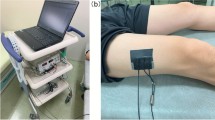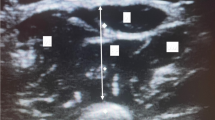Abstract
Patients palliated with Total Cavopulmonary Connection have a lower muscle mass and a lower exercise capacity. We assessed calf muscle oxidative metabolism during and after heel raise exercise to exhaustion in young patients with TCPC compared to healthy peers. Near-infrared spectroscopy was used for measuring oxygen metabolism in the medial portion of the gastrocnemius muscle. Forty-three patients with TCPC, aged 6–18 years, were compared with 43 age and sex-matched healthy control subjects. Subgroups were formed to include children (6–12 years) and adolescents (13–18 years) to determine if these age groups influenced the results. During exercise, for the patients compared to controls there was a lower increase in deoxygenated hemoglobin (oxygen extraction) (5.13 ± 2.99au vs. 7.75 ± 4.15au, p = 0.001) and a slower rate of change in total hemoglobin (blood volume) (0.004 ± 0.015au vs 0.016 ± 0.01au, p = 0.001). Following exercise, patients exhibited a slower initial increase in tissue oxygenation saturation index (0.144 ± 0.11au vs 0.249 ± 0.226au, p = 0.007) and a longer half-time to maximum hyperemia (23.7 ± 11.4 s vs 16.8 ± 7.5 s, p = 0.001). On the subgroup level, the adolescents differed compared to healthy peers, whereas the children did not. Young patients with TCPC had impaired oxidative metabolism during exercise and required a longer time to recover. In that the differences were seen in the adolescent group and not in the children group may indicate a declining function with age.

Similar content being viewed by others
Data Availability
Data available on demand.
Code Availability
Code available on demand.
References
Fontan F, Baudet E (1971) Surgical repair of tricuspid atresia. Thorax 26:240–248
Hoashi T, Shimada M, Imai K, Komori M, Kurosaki K, Ohuchi H, Ichikawa H (2019) Long-term therapeutic effect of Fontan conversion with an extracardiac conduit. Eur J Cardio-thorac Surg 57
Bezuska L, Lebetkevicius V, Sudikiene R, Liekiene D, Tarutis V (2017) 30-year experience of Fontan surgery: single-centres data. J Cardiothorac Surg 12
Atz AM, Zak V, Mahony L, Uzark K, D’Agincourt N, Goldberg DJ, Williams RV, Breitbart RE, Colan SD, Burns KM, Margossian R, Henderson HT, Korsin R, Marino BS, Daniels K, McCrindle BW, Pediatric Heart Network I (2017) Longitudinal outcomes of patients with single ventricle after the fontan procedure. J Am Coll Cardiol 69:2735–2744
Hock J, Reiner B, Neidenbach RC, Oberhoffer R, Hager A, Ewert P, Muller J (2018) Functional outcome in contemporary children with total cavopulmonary connection - Health-related physical fitness, exercise capacity and health-related quality of life. Int J Cardiol 255:50–54
Wolff D, van Melle JP, Bartelds B, Ridderbos FS, Eshuis G, van Stratum E, Recinos SJ, Willemse BWM, Hillege H, Willems TP, Ebels T, Berger RMF (2017) Fontan circulation over time. Am J Cardiol 120:461–466
Hsia TY, Khambadkone S, Redington AN, Migliavacca F, Deanfield JE, de Leval MR (2000) Effects of respiration and gravity on infradiaphragmatic venous flow in normal and Fontan patients. Circulation 102: III148–153
Muller J, Christov F, Schreiber C, Hess J, Hager A (2009) Exercise capacity, quality of life, and daily activity in the long-term follow-up of patients with univentricular heart and total cavopulmonary connection. Eur Heart J 30:2915–2920
Cordina R, O’Meagher S, Gould H, Rae C, Kemp G, Pasco JA, Celermajer DS, Singh N (2013) Skeletal muscle abnormalities and exercise capacity in adults with a Fontan circulation. Heart 99:1530–1534
Brassard P, Bedard E, Jobin J, Rodes-Cabau J, Poirier P (2006) Exercise capacity and impact of exercise training in patients after a Fontan procedure: a review. Can J Cardiol 22:489–495
Sandberg C, Frisk E, Hansson L, Isberg A, Rylander Hedlund E, Sjoberg G, Rydberg A (2020) Impaired knee extension muscle strength in adolescents but not in children with Fontan circulation. Cardiol Young 30:1138–1143
Gewillig M, Brown SC (2016) The Fontan circulation after 45 years: update in physiology. Heart 102:1081–1086
Neary JP (2004) Application of near infrared spectroscopy to exercise sports science. Can J Appl Physiol 29:488–503
Moalla W, Elloumi M, Chamari K, Dupont G, Maingourd Y, Tabka Z, Ahmaidi S (2012) Training effects on peripheral muscle oxygenation and performance in children with congenital heart diseases. Appl Physiol Nutr Metab 37:621–630
Ferrari M, Muthalib M, Quaresima V (2011) The use of near-infrared spectroscopy in understanding skeletal muscle physiology: recent developments. Philos Trans A Math Phys Eng Sci 369:4577–4590
Boushel R, Langberg H, Olesen J, Gonzales-Alonzo J, Bulow J, Kjaer M (2001) Monitoring tissue oxygen availability with near infrared spectroscopy (NIRS) in health and disease. Scand J Med Sci Sports 11:213–222
Boushel R, Piantadosi CA (2000) Near-infrared spectroscopy for monitoring muscle oxygenation. Acta Physiol Scand 168:615–622
Okushima D, Poole DC, Barstow TJ, Rossiter HB, Kondo N, Bowen TS, Amano T, Koga S (2016) Greater V O2peak is correlated with greater skeletal muscle deoxygenation amplitude and hemoglobin concentration within individual muscles during ramp-incremental cycle exercise. Physiol Rep 4: n/a-n/a
Sandberg C, Crenshaw AG, Elcadi GH, Christersson C, Hlebowicz J, Thilen U, Johansson B (2019) Slower skeletal muscle oxygenation kinetics in adults with complex congenital heart disease. Can J Cardiol 35:1815–1823
Sandberg C, Crenshaw AG, Elçadi GH, Christersson C, Hlebowicz J, Thilén U, Johansson B (2021) Patients with complex congenital heart disease have slower calf muscle oxygenation during exercise. Int J Cardiol Congenit Heart Dis 4: 100157
de Onis M, Onyango AW, Borghi E, Siyam A, Nishida C, Siekmann J (2007) Development of a WHO growth reference for school-aged children and adolescents/Mise au point d'une reference de croissance pour les enfants d'age scolaire et les adolescents/ Elaboracion de valores de referencia de la OMS para el crecimiento de escolares y adolescentes.(Research)(Author abstract). Bull World Health Org 85: 660
Taylor LM, Troutman R, Feliciano P, Menashe V, Sunderland C, Porter JM (1990) Late complications after femoral artery catheterization in children less than five years of age. J Vasc Surg 11: 297–304; discussion 304
Ruud E, Natvig S, Holmstrøm H, Wesenberg F (2002) Low prevalence of femoral venous thrombosis after cardiac catheterizations in children: a prospective study. Cardiol Young 12:513–518
Sandberg C, Thilén U, Wadell K, Johansson B (2015) Adults with complex congenital heart disease have impaired skeletal muscle function and reduced confidence in performing exercise training. Eur J Prev Cardiol 22:1523–1530
Cider Å, Carlsson S, Arvidsson C, Andersson B, Stibrant Sunnerhagen K (2006) Reliability of clinical muscular endurance tests in patients with chronic heart failure. Eur J Cardiovasc Nurs 5:122–126
Hamaoka T, McCully KK (2019) Review of early development of near-infrared spectroscopy and recent advancement of studies on muscle oxygenation and oxidative metabolism. J Physiol Sci 69:799–811
Lagerwaard B, Keijer J, McCully K, Boer V, Nieuwenhuizen A (2019) In vivo assessment of muscle mitochondrial function in healthy, young males in relation to parameters of aerobic fitness. Eur J Appl Physiol 119:1799–1808
Chulani VL, Gordon LP (2014) Adolescent growth and development. Primary Care Clin Office Pract 41:465–487
Dotan R, Mitchell C, Cohen R, Klentrou P, Gabriel D, Falk B (2012) Child—adult differences in muscle activation — a review. Pediatr Exerc Sci 24:2–21
Ohuchi H, Ohashi H, Takasugi H, Yamada O, Yagihara T, Echigo S (2004) Restrictive ventilatory impairment and arterial oxygenation characterize rest and exercise ventilation in patients after fontan operation. Pediatr Cardiol 25:513–521
Moalla W, Dupont G, Costes F, Gauthier R, Maingourd Y, Ahmaidi S (2006) Performance and muscle oxygenation during isometric exercise and recovery in children with congenital heart diseases. Int J Sports Med 27:864–869
Vandekerckhove K, Coomans I, Moerman A, Panzer J, De Groote K, De Wilde H, Bove T, Francois K, De Wolf D, Boone J (2019) Differences in cerebral and muscle oxygenation patterns during exercise in children with univentricular heart after Fontan operation compared to healthy peers. Int J Cardiol 290:86–92
Muthalib M, Millet GY, Quaresima V, Nosaka K (2010) Reliability of near-infrared spectroscopy for measuring biceps brachii oxygenation during sustained and repeated isometric contractions. J Biomed Opt 15: 017008
Danduran MJ, Dixon JE, Rao RP (2012) Near infrared spectroscopy describes physiologic payback associated with excess postexercise oxygen consumption in healthy controls and children with complex congenital heart disease. Pediatr Cardiol 33:95–102
Sandberg C, Johansson K, Christersson C, Hlebowicz J, Thilén U, Johansson B (2019) Sarcopenia is common in adults with complex congenital heart disease. Int J Cardiol 296:57–62
Goldberg DJ, Avitabile CM, McBride MG, Paridon SM (2013) Exercise capacity in the Fontan circulation. Cardiol Young 23:824–830
Takken T, Tacken MH, Blank AC, Hulzebos EH, Strengers JL, Helders PJ (2007) Exercise limitation in patients with Fontan circulation: a review. J Cardiovasc Med (Hagerstown) 8:775–781
Takken T, Giardini A, Reybrouck T, Gewillig M, Hovels-Gurich HH, Longmuir PE, McCrindle BW, Paridon SM, Hager A (2012) Recommendations for physical activity, recreation sport, and exercise training in paediatric patients with congenital heart disease: a report from the Exercise, Basic & Translational Research Section of the European Association of Cardiovascular Prevention and Rehabilitation, the European Congenital Heart and Lung Exercise Group, and the Association for European Paediatric Cardiology. Eur J Prev Cardiol 19:1034–1065
Feinstein JA, Benson DW, Dubin AM, Cohen MS, Maxey DM, Mahle WT, Pahl E, Villafañe J, Bhatt AB, Peng LF, Johnson BA, Marsden AL, Daniels CJ, Rudd NA, Caldarone CA, Mussatto KA, Morales DL, Ivy DD, Gaynor JW (2012) Hypoplastic left heart syndrome. J Am Coll Cardiol 59:S1–S42
Olver T, Ferguson BS, Laughlin M (2015) Molecular mechanisms for exercise training-induced changes in vascular structure and function: skeletal muscle, cardiac muscle, and the brain. Prog Molec Biol Transl Sci: 227–257
Cordina RL, O’Meagher S, Karmali A, Rae CL, Liess C, Kemp GJ, Puranik R, Singh N, Celermajer DS (2013) Resistance training improves cardiac output, exercise capacity and tolerance to positive airway pressure in Fontan physiology. Int J Cardiol 168:780–788
Funding
Financial support was provided through the Swedish Heart–Lung Foundation (20160496) and the Swedish Odd Fellow Order.
Author information
Authors and Affiliations
Contributions
All authors contributed to the study conception and design. Participant invitation and informed consent gathering were performed by Magne Sthen Bergdahl and Camilla Sandberg. Data collection was mainly done by Camilla Sandberg and Albert Crenshaw. Data analysis were performed by Magne Sthen Bergdahl and Albert Crenshaw. The first draft of the manuscript was written by Magne Sthen Bergdahl and all authors commented on previous versions of the manuscript. All authors read and approved the final manuscript.
Corresponding author
Ethics declarations
Conflict of interest
The authors declare that they have no conflict of interest.
Ethical Approval
The study was approved by the Regional Ethical Review Board in Umeå, Sweden (Dnr: 2016-445-31 M).
Consent to Participate
Prior to the study, caregivers provided informed written consent for the subjects younger than 18 years and those who were 18 years gave consent themselves.
Consent for Publication
All authors consent publication.
Additional information
Publisher's Note
Springer Nature remains neutral with regard to jurisdictional claims in published maps and institutional affiliations.
Rights and permissions
About this article
Cite this article
Bergdahl, M.S., Crenshaw, A.G., Hedlund, E.R. et al. Calf Muscle Oxygenation is Impaired and May Decline with Age in Young Patients with Total Cavopulmonary Connection. Pediatr Cardiol 43, 449–456 (2022). https://doi.org/10.1007/s00246-021-02743-6
Received:
Accepted:
Published:
Issue Date:
DOI: https://doi.org/10.1007/s00246-021-02743-6




